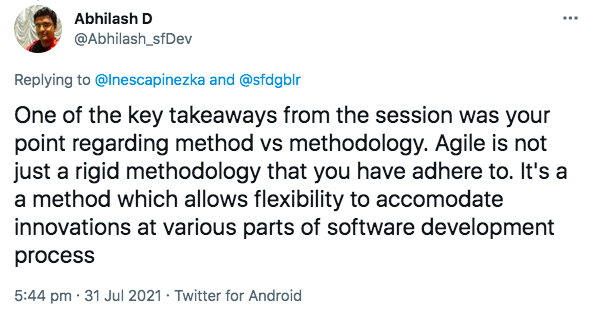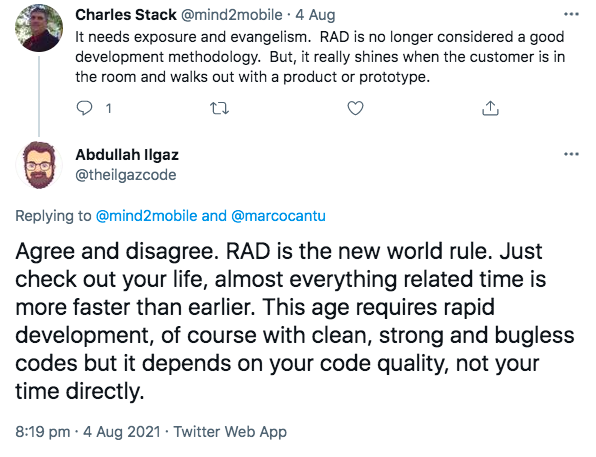Within the competitive software industry, there can be no space for mistakes. Software testing methodologies are pivotal for the software development life cycle, guiding how you should conduct the tests.
Let me give you an example of the popular messaging app Slack. In 2021, it received a massive flake from customers for the Slack Connect DM feature.
The feature allowed anyone to send a DM without their permission or knowledge. Also, there was no way to turn off this feature. Slack had to remove that feature and seek a public apology for users’ inconvenience.
If only Slack had conducted acceptance and beta testing before releasing the new feature, the condition wouldn’t be this worse! The incident proves that while the software development process requires meticulous planning, testing methodologies are equally crucial for delivering a quality product. So, what are these software testing methodologies, and what difference does it make to your applications?
Let’s find out!
Software Testing Methodology
The methodology is a testing strategy for simultaneously developing and testing a software application to meet the clients’ requirements. The testing approach defines the project management, organizational structure, and software testing methods. It basically lays out the plans for conducting the tests, explains the team’s responsibilities, and opens the line of communication with respective stakeholders. Each methodology has a defined test objective that varies depending on the application, client expectations, delivery time, and the iterations it might take.
Types of Software Testing
The different types of software testing are the technical side of the testing process that ensures the application is performing as intended. It is categorized into functional testing and non-functional testing. The functional tests check the application against business objectives, requirements, and functionings of its desired specifications and compatibility testing. The non-functional tests cover the app performance, security, usability testing, QA testing, and the operating system. Some popular software testing types include – acceptance testing, black box testing, exploratory testing, regression testing, white box testing, stress testing, and many others.
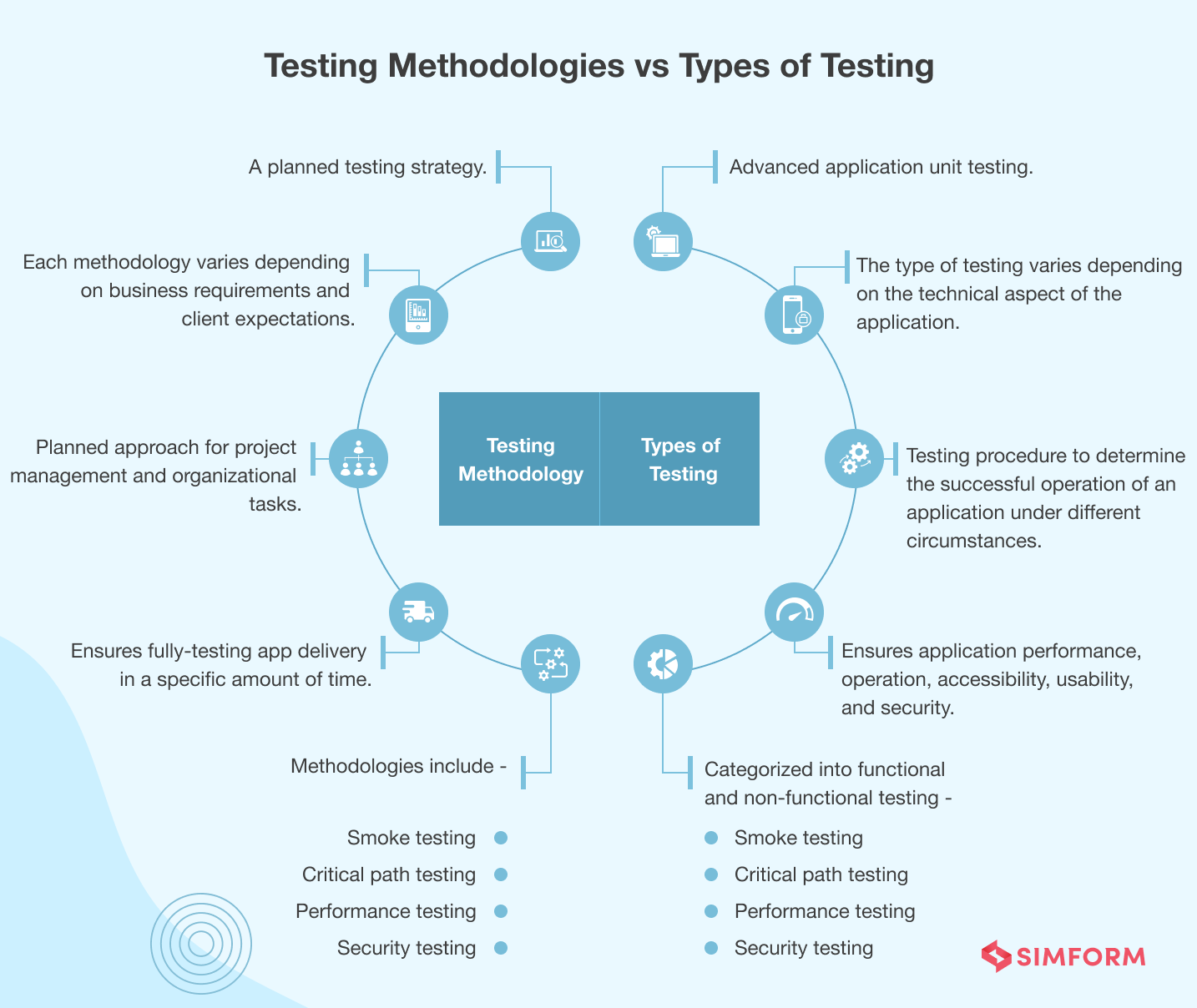
Seven Popular Software Testing Methodologies
While there are several models for testing, the list below emphasizes some of the popular and most used ones.
1. Waterfall Methodology
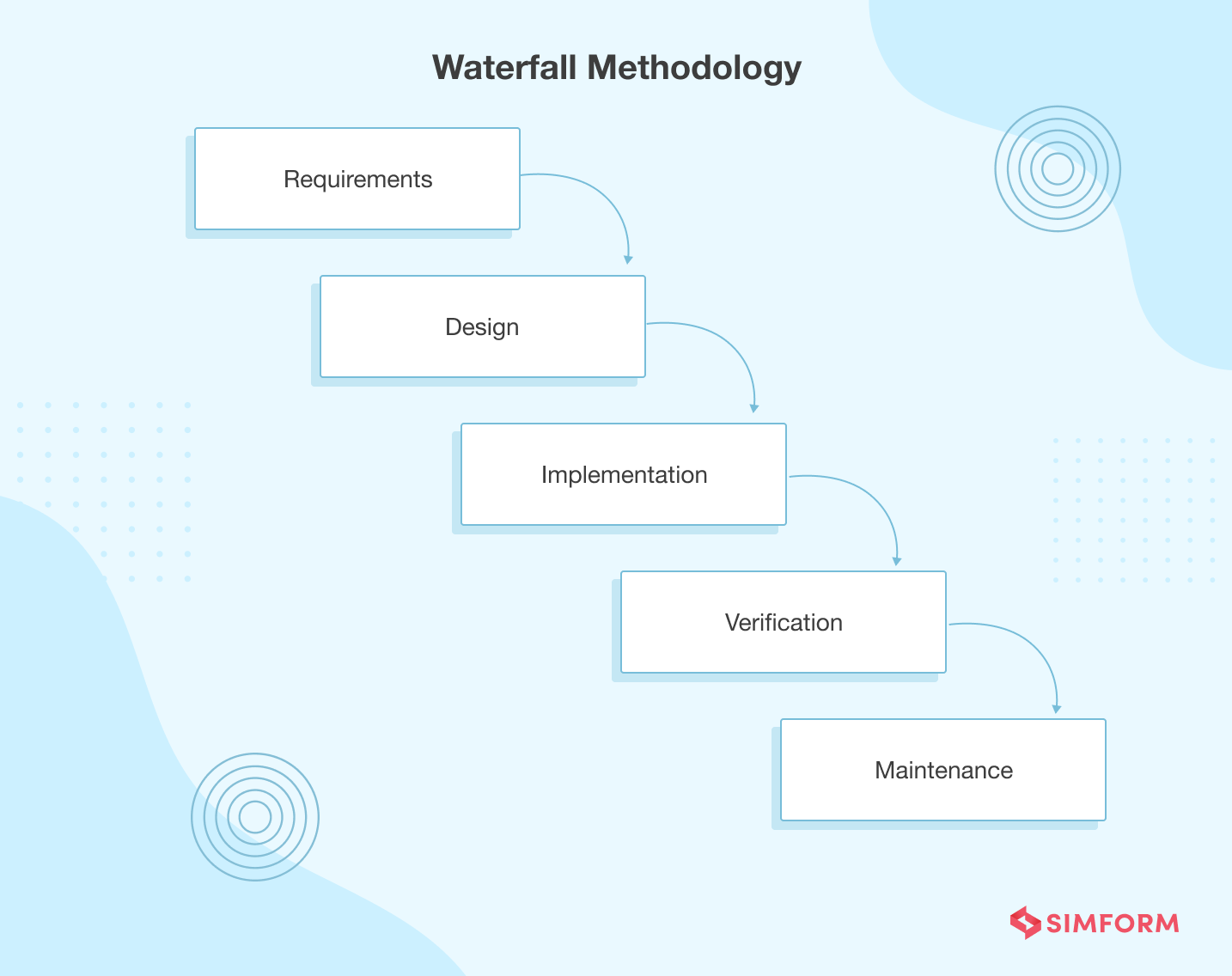
Amongst the rigid software testing methodologies, the waterfall methodology is one of those models where the focus is on a development process that follows a vertical path. It is characterized by its sequential processes where the next phase of the development process only begins after the previous phase is completed. There are five predefined phases within the waterfall model: Requirements, Design, Implementation, Verification, and Maintainance.
Testing Approach
The sequential path of a waterfall methodology has defined steps of order –
The ‘requirements’ phase ensures all the necessary requirements like testing objectives, organizational planning, draft documents, and the testing strategy is defined and fixed. The rigid documentation and planning make this model suitable for small applications compared to complex apps that might go through extensive changes.
The project ‘design’ is then selected and approved by the decision-maker. Next, the development team implements the detailed design plan, and once it’s done, it’s ‘verified’ by the QA team and stakeholders. Once the project is verified and launched, the development team starts with ‘maintaining’ the software product until it is thoroughly tested for the final launch.
Advantages
- It is a step-by-step laid out test strategy.
- The methodology can be used to easily to plan and manage project requirements.
- It is inexpensive and provides faster delivery of projects.
Disadvantages
- Each step in the methodology is predefined and cannot be skipped.
- It can’t absorb unplanned iterations.
- Testing is pushed down for later in the list.
- Even a slight iteration to the project plan can be expensive.
Use Cases
- Customer Relationship Management systems
- Human Resource Management systems
- Supply Chain Management systems
- Inventory Management systems
- Point of Sale systems
2.Agile Methodology
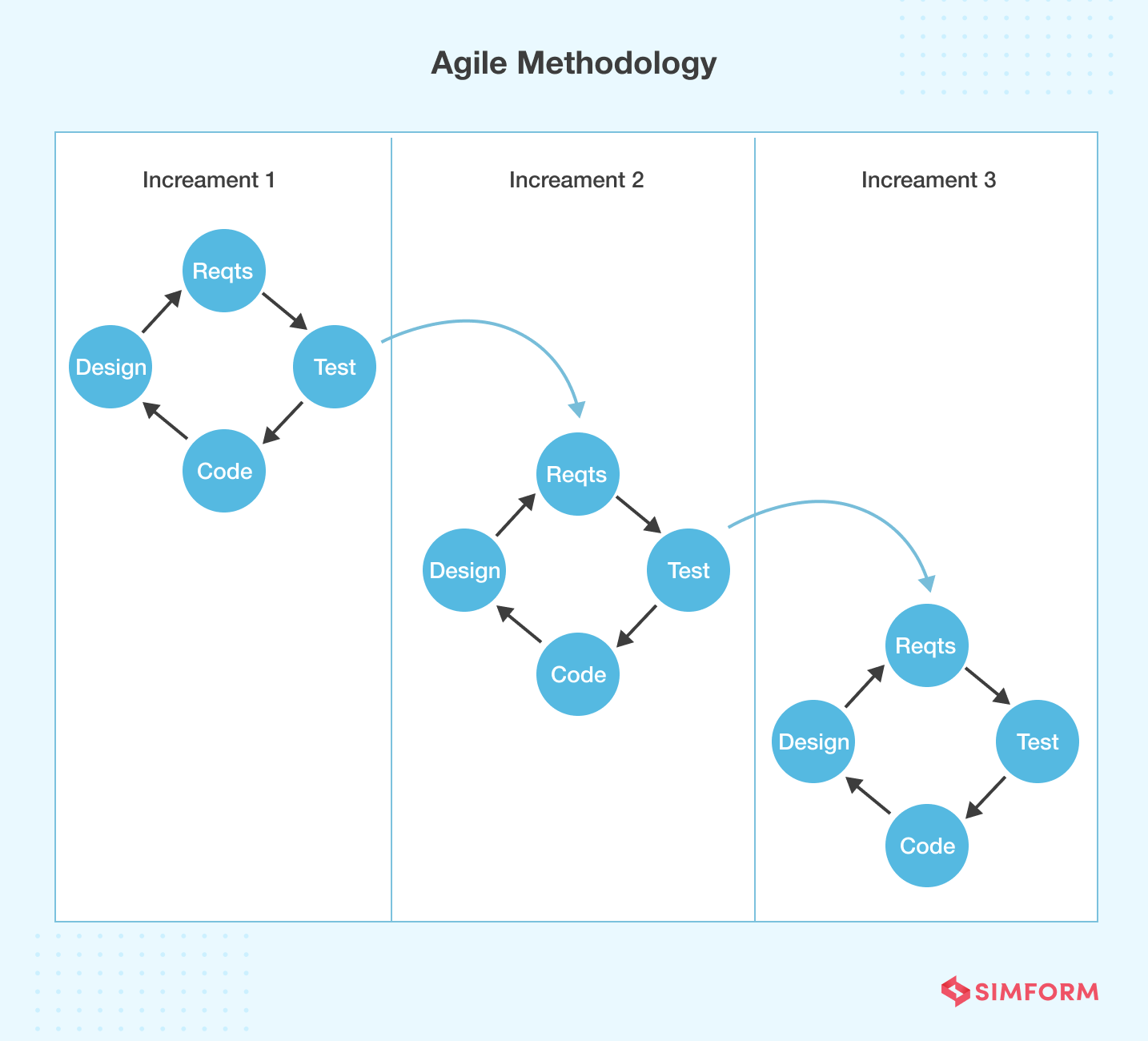
The agile testing methodology is based on the idea of iterative development, where development progress is made in rapid incremental cycles, also known as sprints. With complex applications and swift market demands, the agile methodology opens interactions with stakeholders to better understand their requirements. The communication cycle allows the team to focus on responding to the changes instead of relying on extensive planning that might eventually change.
Testing Approach
The origin of the agile methodology was meant to break away from the rigid and model of development and testing that does not give space for iterations. This is one of the reasons that the testing team prefers using this approach for dynamic applications to accommodate constant feedback from stakeholders. With less priority towards documentation and more towards implementing changes, incremental tests and iterations are made instantaneously.
Instead of testing the entire system towards the end, every suggested iteration release is tested thoroughly. Furthermore, each iteration has its own cycle of requirements, design, coding, and testing cycle, making it a cyclical process. The test-driven development model is mostly used for adding new functionalities to an existing system, making it suitable for small projects with tight deadlines.
Advantages
- Complex application processes can be easily managed, changed, and tested.
- Incremental tests minimize the cost and risks associated with numerous changes.
- The constant communication between developers and clients determines the progress of the software application.
- The focus of the methodology is on testing rather than planning.
Disadvantages
- Increased to and fro with clients may lead to longer delivery times.
- Less priority on planning may lead to documentation inefficiencies.
- Constant changes make maintenance difficult.
Use Cases
- Defining the testing scope of an application.
- New functionalities in an application
- Load and performance testing
3. Iterative Development Methodology
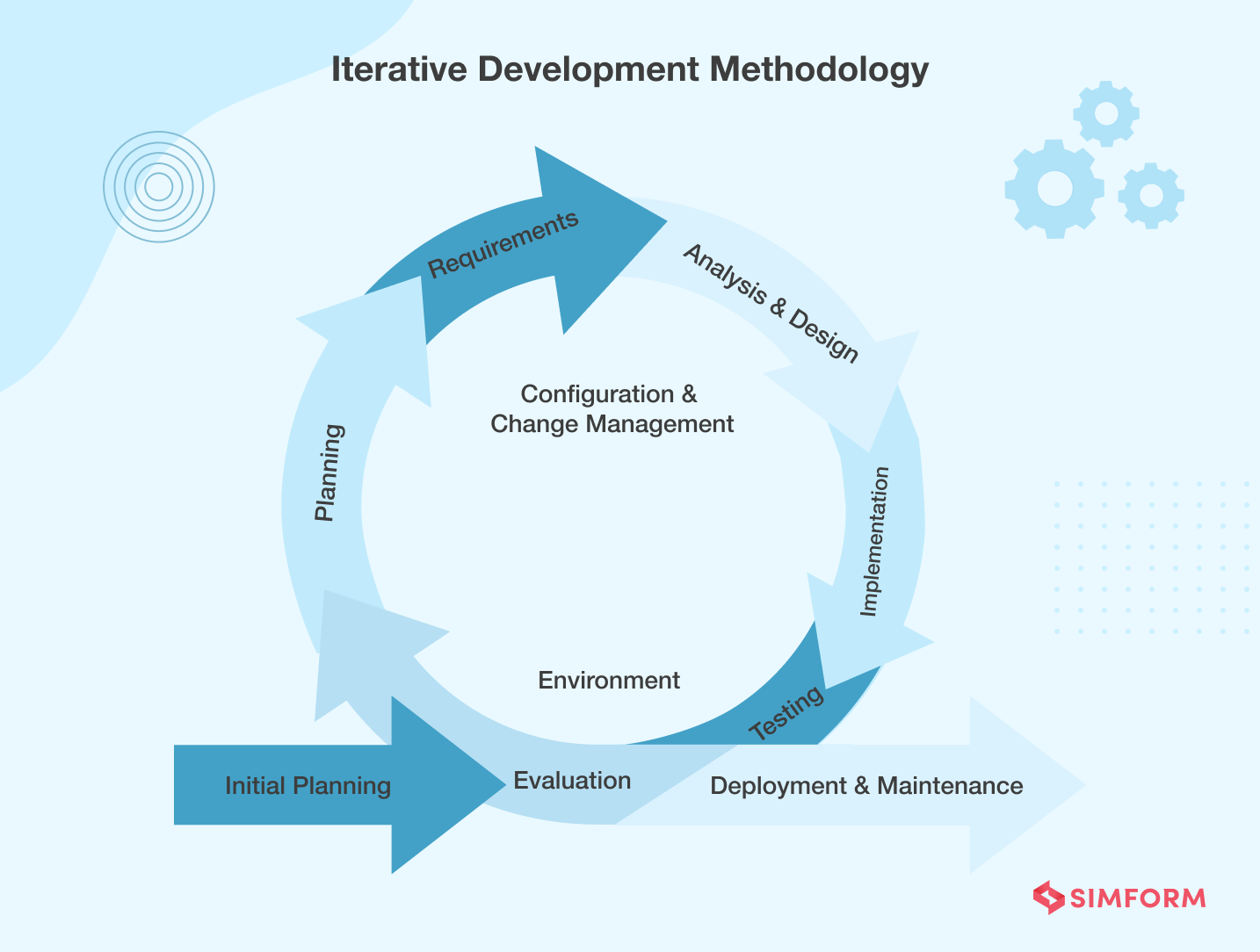
The methodology works by breaking down a large project into smaller components, where each component goes through a series of testing cycles. It is a data-driven model, and each iteration is based on the results of the previous test cycle. The repeated tests ease organizational management and streamline the software requirements before merging them into a final product.
Testing Approach
The iterative development model follows a cyclical pattern for testing smaller components of a large project. Each iteration cycle is identical to a complete development cycle and consists of planning, design, testing, and evaluation phases. Once a cycle is complete, the component is added as an upgrade in the software.
When software application requirements are loosely defined, the feedback from each iteration improves the functionality of the final product. This is the reason the model is most suitable for flexible applications with a focus on scalability.
Advantages
- Smaller iterations for complex software applications decrease the time and cost of development.
- Feedbacks of the iterative cycles are immediately available.
- With each iteration cycle, the errors and bugs get removed at the initial development stages.
- The model allows more flexibility and focuses on the design instead of documentation.
Disadvantages
- Communication overheads might increase significantly after each feedback. iteration
- The iteration cycle is rigid and cannot be overlapped.
- Unpredictable feedback might delay the delivery of the final product.
- A low priority on planning might lead to unforeseen circumstances.
- User engagement is necessary for identifying risks.
Use Cases
- Gaming applications
- Streaming applications
- SaaS applications
- Prototype testing
4. Verification and Validation Methodology
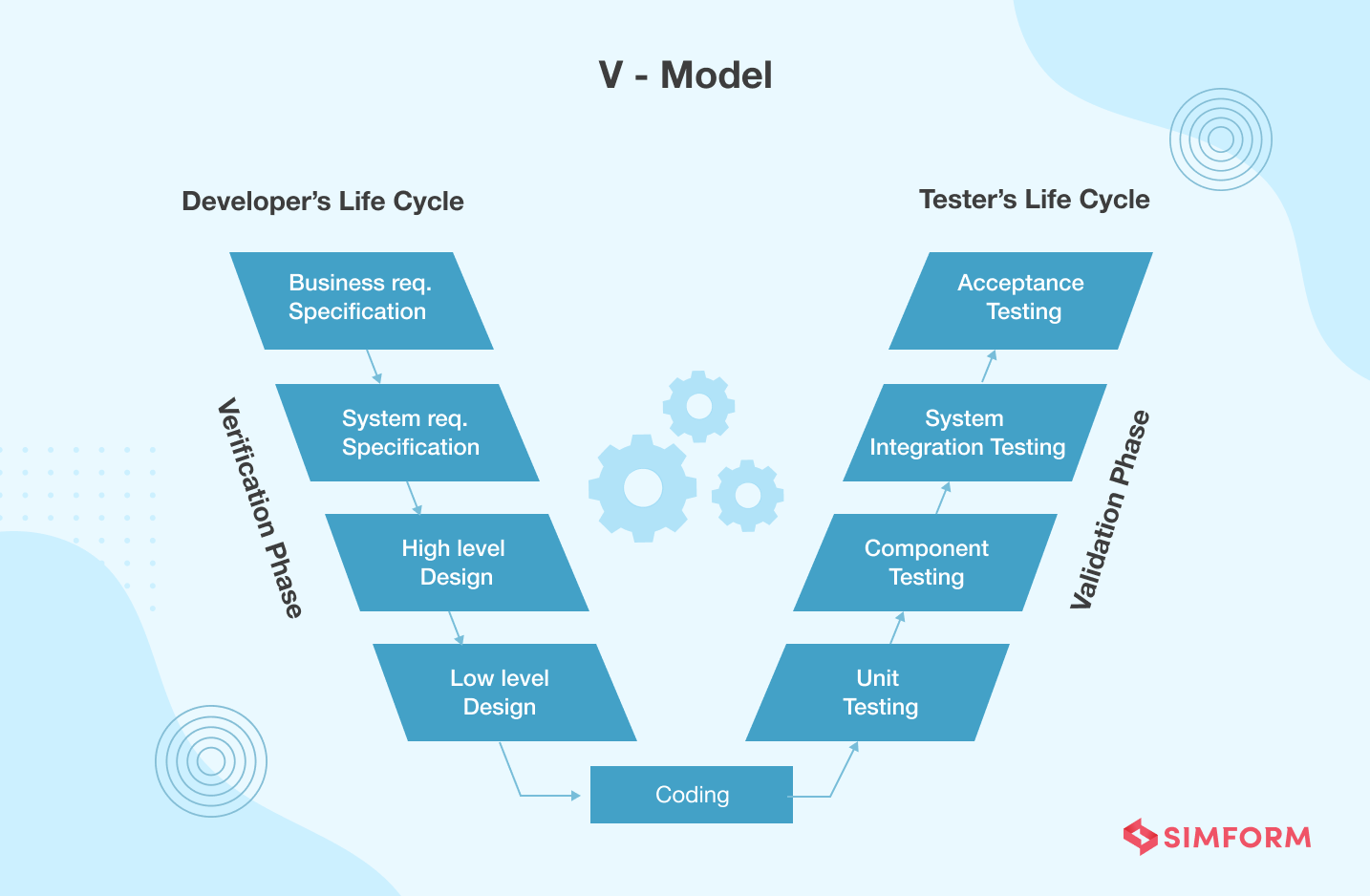
The V-methodology is considered an extension of the waterfall model, used for small projects with defined software requirements. It follows a ‘V-shaped’ model that is categorized into coding, verification, and validation. With coding being the base of the model, each development phase goes hand-in-hand with testing, resulting in the early detection of errors in each step.
Testing Approach
The ‘V-model’ stands apart from the waterfall model in terms of parallel testing procedures conducted at each development stage. The verification process ensures that the product is developed correctly, while the validation process ensures that it’s the right product as per requirements.
The model starts with the static verification processes that include a business requirement analysis, system design, architectural design, and module design. Next, the coding phase ensures that a specific language and tools are chosen based on the coding standards and guidelines. Finally, the last phase of the validation ensures that each module and stage of development goes through unit testing, integration testing, system testing, and application testing.
Advantages
- Testing/validation at each stage allows the identification of errors early in the development cycle.
- It’s a cost and time-effective testing model.
- The rigidity makes it ideal for small projects.
- Each stage of the validation and verification has well-defined objectives.
Disadvantages
- There is no inherent ability to respond to errors during the testing process.
- There is no defined solution for eliminating the software defect.
- The model is not suitable for large projects with higher chances of changes.
- It cannot handle concurrent events.
- There is no going back after a module has entered the testing phase.
Use Cases
- Medical devices and software applications.
- Government applications and software projects.
- Defense projects and applications.
- Commercial applications.
5. Rapid Action Development Methodology
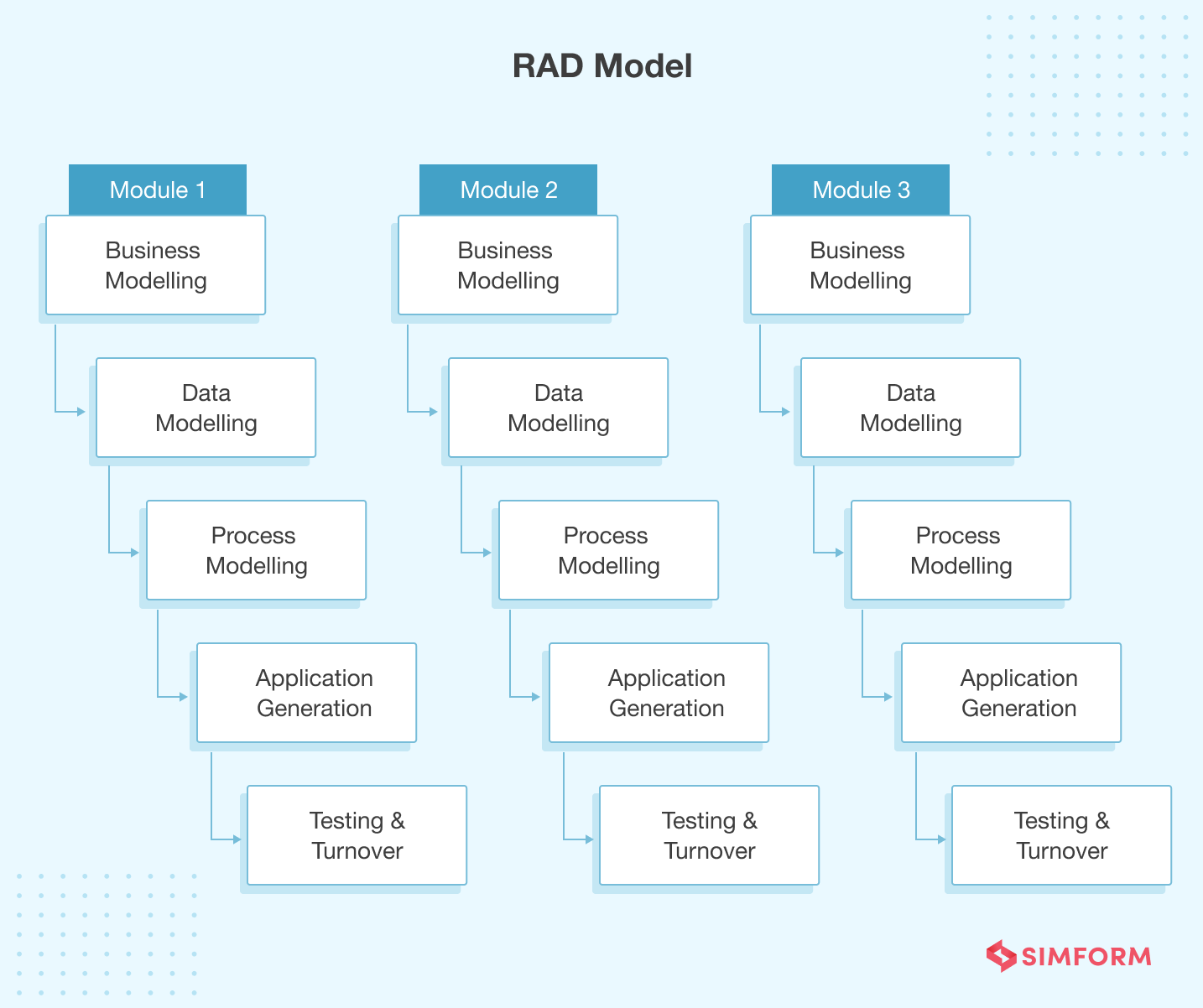
The testing model is a form of an incremental methodology that originated out of the agile software development system. The cornerstone of RAD is prototyping while parallelly developing components for the software, therefore, focusing more on testing rather than planning and documentation. While each software function is divided and designed as separate components, they are merged to form a prototype, collect end-user feedback, and make further iterations accordingly.
Testing Approach
The RAD methodology consists of five phases through which the system components are developed and tested simultaneously. Each of these phases is time-bound and must be done promptly, making it suitable for projects with a tight deadline.
The first phase, ‘Business Modeling’, identifies the business requirements and determines the flow of information towards other business channels. Once the flow is determined, the ‘Data Modeling’ phase reviews relevant data as per the business model.
The third, ‘Process Modeling’, converts data objects to establish a business information flow. The phase defines the QA process through which the data objects can be further modified as per client feedback. This is done while keeping in mind that the application might go through multiple iterations over time.
The fourth stage of ‘Application Generation’ is known as the prototyping phase, and the models are coded with automated tools. Finally, each prototype is individually tested in the ‘Testing and Turnover’ phase, reducing the errors and risks in the overall software application.
Advantages
- Simultaneous designing and reusability of the prototypes reduce development and testing time.
- The time-box approach at each incremental stage reduces the overall risks in the software project.
- Feedback cycles increase customer satisfaction.
- The progress is measurable and data-driven.
- Changes can be easily accommodated.
Disadvantages
- The methodology is challenging to use with legacy systems.
- Continuous client feedback and modifications can delay the deployment.
- There is a high dependency on technical skills and resources.
- Automation testing, tools, and code generation lead to higher costs.
Use Cases
- Enhancing application graphic user interface.
- Application prototypes (Wireframe, Design, and Clickable prototype)
- System modularization.
6. Spiral Methodology
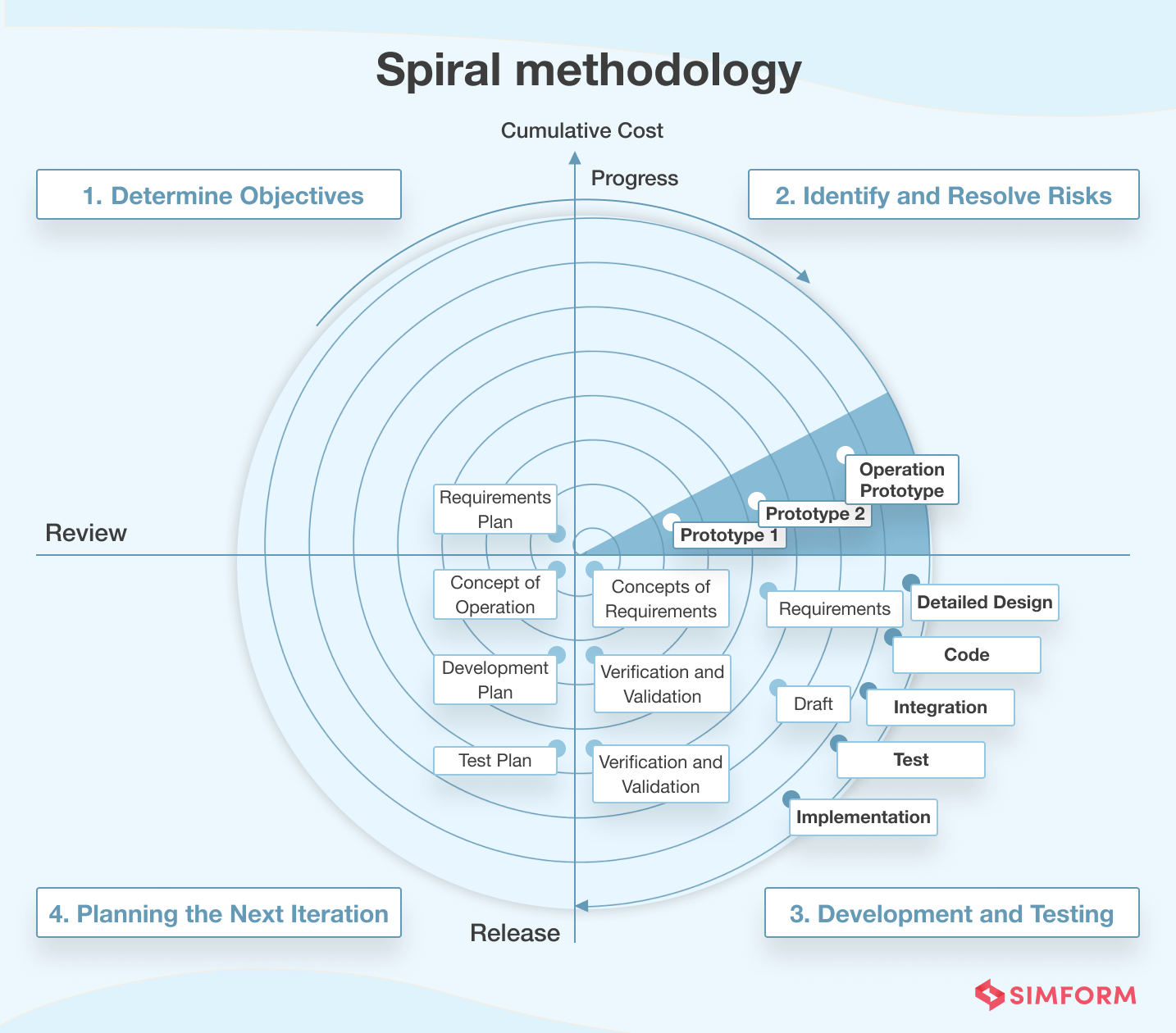
The spiral methodology is one of the most popular software testing methodologies focusing on risk handling. As the name suggests, the spiral method comprises many loops, where each loop enhances the software and delivers small prototypes of the powerful software.
In the Spiral model, each loop is one phase of the software development process. Its radius represents the project’s total expense, while the angular dimension represents its progress.
Testing Approach
Each phase of the spiral model gets divided into four quadrants, as shown in the figure. Each of these quadrants has unique functions. Let’s discuss them one by one in detail.
- The first phase is ‘Objectives determination and alternate solution identification.’ It starts with gathering customer requirements to identify, elaborate, and analyze the objectives. And spending some time identifying alternative solutions for this particular quadrant. At the end of this phase, you’ll have a software requirement specification document ready for your project.
- Risk identification and rectification is the second quadrant that helps evaluate all the possible solutions to determine the best solution that aligns with your project requirements. This is followed by risk identification and strategy planning to rectify those errors.
- New product version development is the third quadrant that focuses on developing the features identified in earlier phases and then verifying them through rigorous testing.
- Finally, the last phase allows end-customers to review the newest version of the product and provide feedback that will help plan the next version.

Advantages
- It allows you to conduct risk analysis efficiently.
- It enables you to incorporate the changes in requirements at later stages.
- Highly suitable for large and complex software development projects.
- Robust feedback mechanism and emphasis on rich documentation.
Disadvantages
- Not suitable for smaller projects as it’s an expensive model.
- Hard to define objectives and verify milestones.
- Too much dependence on risk analysis and requires technical expertise.
- Difficult to identify the end of the project as the spiral goes on indefinitely.
Use Cases
7. Extreme Programming (XP) Methodology
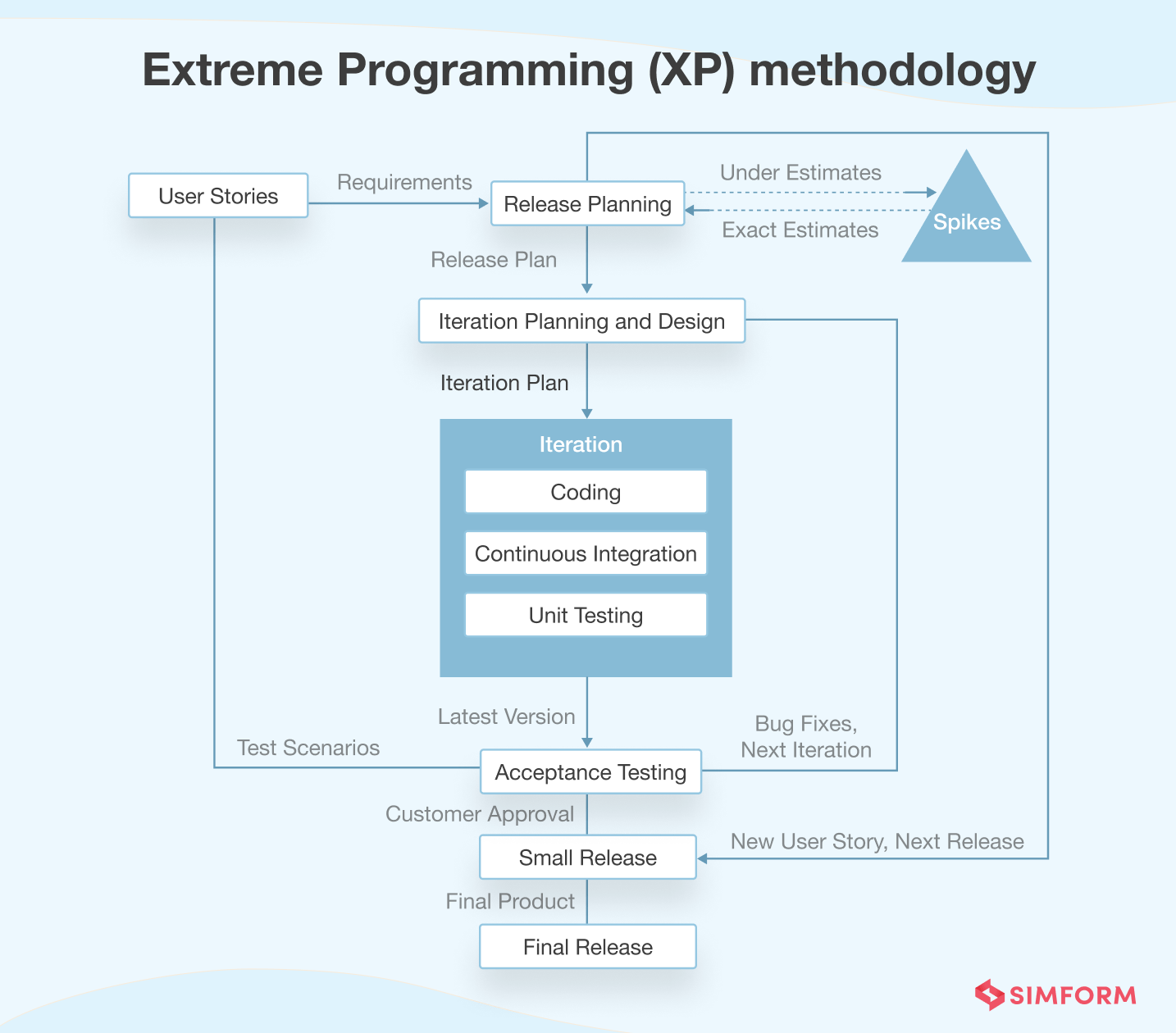
Extreme Programming (XP) software testing methodology improves software quality by encouraging constant customer feedback. The methodology recommends the software development teams learn from previous experiences and incorporate best practices such as code review, continuous testing, incremental development, integration testing, etc.
Testing Approach
The XP framework involves five major phases or development stages that iterate continuously:
- In the planning phase, customers meet the software team to present their requirements and envision the final product. The business analyst team develops a software requirement specification document and creates a release plan for various features by breaking them into milestones. If the software team can’t estimate any requirements, they introduce spikes into the lifecycle, which requires further research.
- Next is the designing phase; it’s part of the planning process, but software teams consider it a separate phase as it impacts the product’s user experience. Here, the focus is on one of the XP best practices, i.e., simplicity. By simplicity in design, we mean clear-cut layout, simple navigation, proper usage of white space, minimal components, a bright color palette, etc. All these things help reduce the complexities and redundancies.
- The coding phase focuses on the coding standards, pair programming, continuous integration, and collective code ownership to develop clean and comprehensive code for the project.
- The testing phase ensures that rigorous unit, integration, and acceptance tests are conducted to determine whether a particular feature is working correctly, whether the integrated functionality provides the expected output, and whether the customer is pleased with the outcome of the finished product.
- Lastly, listening is all about constant communication and feedback. The customers provide clear-cut feedback on the improvement required, and the project managers note it down to incorporate those things during the development of the next iteration.
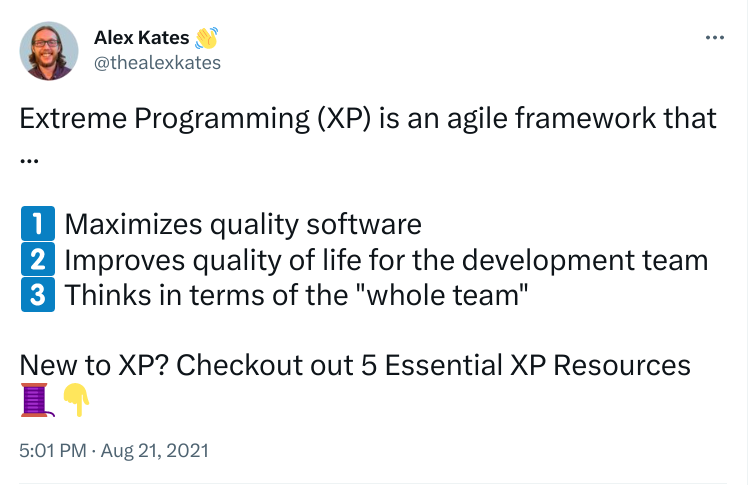
Advantages
- It allows you to make changes in software development at short notice.
- The code is straightforward to understand at all times.
- It enables you to save time and cost for project realization.
- Encourages constant feedback to develop a robust product.
Disadvantages
- There is no emphasis on maintaining and measuring code quality.
- It does not focus much on design, which is an important aspect.
- Requires you to have strong version control management in place.
- It needs constant customer attention and review throughout the project.
Use Cases
Conclusion
Testing has always been an integral part of the software development life cycle. It enhances application performance, improves security, and provides quality assurance. But it is not as simple as utilizing a testing tool and running the application to look for errors.
Testing goes hand-in-hand with planning, designing, implementing the code, and it would be wrong to treat it as an isolated process. Each software testing methodology offers productive solutions that make sure a software project meets the business requirements and maintains the user experience.
With a talented pool of developers, our goal at Simform has always been to provide the best software testing services that drive product quality and customer satisfaction. Our selection of a testing methodology ensures that every software project goes through a rigorous testing process to offer the best product outcome.
You can get an unbiased objective evaluation of your software applications from our experts and evaluate your testing strategies. Reach out to us by signing up or leaving a comment about your thoughts.

